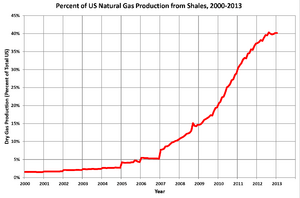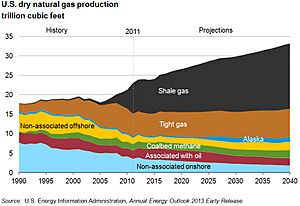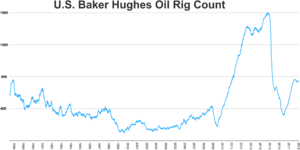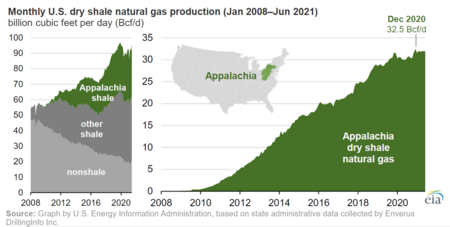Shale gas in the United States facts for kids
Shale gas in the United States is a type of natural gas found deep underground in shale rock. It's considered an unconventional source because it's trapped differently than regular natural gas. Thanks to new ways of drilling, like hydraulic fracturing (often called "fracking") and horizontal drilling, the U.S. has found a lot more natural gas. These new methods have helped make up for less gas coming from older, traditional sources. Because of these discoveries, the amount of natural gas the U.S. had in 2008 was 35% higher than in 2006.
In 2007, some of the biggest natural gas sources in the U.S. were shale gas fields. The number of wells that drill for this special type of gas grew from about 18,500 in 2004 to over 25,000 in 2007. The success of shale gas in the U.S. has made other countries like Canada, Europe, Asia, and Australia interested in finding their own shale gas. Some people believe the U.S. might have enough natural gas to last 100 years, but only a smaller part of that is currently proven and ready to be used.
Contents
How Shale Gas is Produced
Shale gas production in the U.S. grew very quickly after 2008. This happened because the natural gas industry worked with the United States Department of Energy to make drilling and extraction methods better. In 2008, the U.S. produced about 2 trillion cubic feet of shale gas, which was a 71% increase from the year before. By 2009, production jumped another 54% to over 3 trillion cubic feet.
The U.S. Energy Information Administration (EIA) greatly increased its estimate of how much shale gas could be recovered. In 2011, they thought there were about 827 trillion cubic feet of recoverable shale gas. This was much higher than their earlier estimate of 353 trillion cubic feet. However, in 2012, the EIA lowered its estimate to 482 trillion cubic feet. It is expected that shale gas will make up a larger part of all U.S. gas production, possibly reaching 49% by 2035.
Having so much shale gas available in the U.S. has led some people to suggest using gas-fired power plants instead of coal plants. Gas plants produce less carbon pollution. They can also act as backup power for wind energy when the wind isn't blowing.
By March 2015, shale gas production had nearly doubled since June 2011. It provided 55% of all dry natural gas produced in the U.S. Even with this fast increase in production, companies found new reserves of shale gas even faster. By the end of 2013, the amount of proven shale gas reserves still in the ground had grown by 63% since 2010.
New technology and more experience have made drilling for shale gas much more efficient. For example, wells drilled in the Marcellus Gas Trend in January 2014 produced nine times more gas per day of drilling time than wells drilled five years earlier.
History of Shale Gas
The first time shale gas was taken out of the ground was in Fredonia, New York, in 1825. This was done from shallow cracks in the rock.
Later, in 1915, the Big Sandy gas field in Kentucky started producing gas from naturally cracked shale. By 1976, this field covered thousands of square miles. Since the 1940s, explosives were used to help gas flow from these wells. In 1965, some companies started using hydraulic fracturing with water and sand to increase production. However, the amount of gas from each well was small and depended on natural cracks in the rock.
Other commercial gas production from shale became common in the 1920s in different parts of the U.S., but the amounts were usually small.
After 2008, U.S. shale natural gas production grew very quickly. This period is sometimes called the "shale gas revolution." It reversed a trend where U.S. natural gas production had been falling for decades. In the 2010s and early 2020s, the U.S. produced so much natural gas that it started selling it to other countries.
Government's Role in Shale Gas
The U.S. government has had different effects on natural gas production. Sometimes, government rules made it harder for new ideas to develop. Other times, government research helped improve gas production methods.
In the 1970s, federal price controls on natural gas led to shortages. To deal with this, the government invested in finding new ways to get gas. This included the Eastern Gas Shales Project (1976-1992) and research funded by the Gas Research Institute. The United States Department of Energy also worked with private companies. In 1986, they completed the first successful horizontal well in shale that used multiple fractures.
The Eastern Gas Shales Project focused on improving gas recovery in known shale areas. They used two methods that companies had already developed: massive hydraulic fracturing and horizontal drilling. In 1976, engineers working for the government patented an early way to drill directionally in shale.
The government also offered tax credits and rules that helped the industry. From 1980 to 2000, gas from Devonian shales was not controlled by federal prices. Also, tax credits were given for unconventional gas, including shale gas.
Even with government help, shale gas was still seen as difficult to get economically without tax credits. In 2000, when the federal tax credits ended, shale gas made up only 1.6% of U.S. gas production. However, some experts believe these government programs helped set the stage for the big shale gas boom that followed.
In 1991, Mitchell Energy (now Devon Energy) completed the first horizontal fracture in the Texas Barnett shale. This project received support from the Gas Technology Institute. The first attempts with horizontal wells were not successful for Mitchell Energy. The Barnett Shale became very successful using vertical wells first. It wasn't until 2005 that more horizontal wells were drilled than vertical ones in the Barnett.
Barnett Shale Success
Mitchell Energy started getting gas from the Barnett Shale in North Texas in 1981. At first, it wasn't profitable. But the company kept trying new methods for years. Mitchell found a very successful way to fracture the Barnett Shale in 1998 using "slick-water fracturing." The United States Geological Survey noted that this technique was key for fracturing shales. Even though Mitchell tried horizontal wells, early results weren't good. The Barnett Shale became very successful with vertical wells first. By 2008, 94% of new wells drilled in the Barnett were horizontal.
Since the success of the Barnett Shale, natural gas from shale has become the fastest-growing energy source in the U.S. This has encouraged many other countries to look for shale deposits. Experts believe that getting shale gas economically could more than double the amount of natural gas available, from a 125-year supply to over 250 years.
In 1996, shale gas wells in the U.S. produced about 0.3 trillion cubic feet, which was 1.6% of U.S. gas production. By 2006, production had more than tripled to 1.1 trillion cubic feet per year, making up 5.9% of U.S. gas production. In 2007, a record 4,185 shale gas wells were completed in the U.S.
The success of the Barnett Shale in Texas in 2005, due to new technology, gave the industry confidence. Similar operations soon started in other areas, like the Fayetteville Shale in Arkansas and the Haynesville Shale in Louisiana.
In 2008, a study by professors Terry Engelder and Gary G. Lash greatly increased the estimated amount of gas in the Marcellus shale. This report spread throughout the industry.
Shale Gas Locations
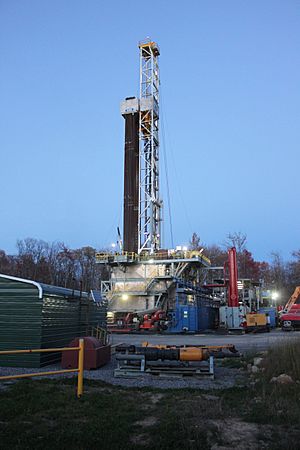
Antrim Shale, Michigan
The Antrim Shale in Michigan has produced gas since the 1940s. Unlike other shale gas areas, the gas from the Antrim seems to be "biogenic gas." This means it was made by bacteria working on the organic-rich rock. In 2007, the Antrim gas field was the 13th largest source of natural gas in the U.S.
Barnett Shale, Texas
The first well in the Barnett Shale was completed in 1981 in Wise County. Drilling greatly increased because of higher natural gas prices and the use of horizontal wells. Barnett Shale wells are much deeper than older shale gas areas, going down to 8,000 feet. The success of the Barnett has encouraged exploration in other deep shale areas. In 2007, the Barnett shale was the second-largest source of natural gas in the U.S. It currently produces more than 6% of all U.S. natural gas.
Fayetteville Shale, Arkansas
The Fayetteville Shale in Arkansas produces gas. The productive part of the shale varies in thickness and depth. Gas was first produced using vertical wells, but companies are now increasingly using horizontal wells in the Fayetteville.
Haynesville Shale, Louisiana
The Haynesville Shale in northwest Louisiana has produced gas since 1905. However, it became a major focus for modern shale gas drilling after a discovery in November 2007. Haynesville shale wells have also been drilled in northeast Texas.
Collingwood-Utica Shale, Michigan
From 2008 to 2010, a company called Encana (now Ovintiv) bought a lot of land in Michigan for the Collingwood Utica shale gas play. Natural gas is produced from the Collingwood shale and the Utica shale above it.
New Albany Shale, Illinois Basin
The New Albany Shale produces gas in parts of Illinois, Indiana, and Kentucky. This shale has been a gas producer for over 100 years. However, better well technology has increased drilling activity. The gas here is a mix of biogenic (from bacteria) and thermogenic (from heat and pressure) origins.
Devonian Shales, Appalachian Basin
The upper Devonian shales in the Appalachian Basin have produced gas since the early 1900s. The main producing area is in Virginia, West Virginia, and Kentucky, and extends into Ohio and Pennsylvania. More than 20,000 wells produce gas from Devonian shales in this area. The most commonly produced shale is the Chattanooga Shale, also called the Ohio Shale.
Marcellus Shale
The Marcellus Formation in West Virginia, Pennsylvania, and New York was once thought to be used up. However, with horizontal drilling, it is now estimated to hold a huge amount of gas. It has been suggested that the Marcellus shale could supply the northeastern U.S. with natural gas.
Woodford Shale, Oklahoma
The Devonian Woodford Shale in Oklahoma is between 50 and 300 feet thick. Although gas was first produced in 1939, there were only 24 Woodford Shale gas wells by late 2004. By early 2008, there were over 750 wells. Like many shale gas areas, the Woodford started with vertical wells, then mostly switched to horizontal wells. Large gas producers operate in the Woodford. Production from the Woodford Shale reached its highest point in 2011 and has been declining since then.
Economic Effects
In 2010, the development of shale gas created 600,000 jobs in the U.S. Having affordable natural gas is important for industries like chemicals, manufacturing, and steel. There are worries that these benefits might be lost if the U.S. exports too much natural gas.
The American Chemistry Council believes that a 25% increase in the supply of ethane (a liquid from shale gas) could create over 400,000 jobs. It could also bring in over $4.4 billion each year in taxes and encourage $16.2 billion in new investments by the chemical industry. They also note that the low price of ethane gives U.S. manufacturers an important advantage over many global competitors.
Similarly, the National Association of Manufacturers estimated that a lot of shale gas and lower natural gas prices could help U.S. manufacturers employ 1,000,000 more workers by 2025. Lower costs for materials and energy could also help them save as much as $11.6 billion by 2025. In December 2011, America's Natural Gas Association (ANGA) estimated that lower gas prices would add an extra $926 to household income each year between 2012 and 2015. This amount could increase to $2,000 by 2035. Over $276 billion is being invested in the U.S. Petrochemical industry, mostly in Texas. Because of shale gas, coal consumption in the U.S. has gone down since 2009.
A 2017 study found that hydraulic fracturing helped create jobs and increase wages. It showed that new oil and gas drilling led to 725,000 more jobs in the U.S. and a 0.5% drop in the unemployment rate during the Great Recession. Research also shows that shale gas wells can affect house prices. Homes that rely on groundwater might see their value drop by 13%, while homes with piped water might see a 2-3% increase. The increase for piped-water homes is likely due to royalty payments that property owners get from gas extracted under their land.
The question of whether to export natural gas has caused disagreements among businesses. Manufacturers want to keep gas prices low in the U.S. Energy companies, however, want to raise prices by selling natural gas to more countries. Manufacturers are concerned that more exports will hurt their businesses by making U.S. energy prices go up. Several studies suggest that the shale gas boom has given U.S. manufacturing a competitive edge. This has led to a boom in exports from energy-intensive manufacturing.
In 2014, many companies were losing money. However, the companies that were making money focused on getting high-quality land. In 2016 and 2020, a worldwide oversupply caused natural gas prices to drop very low. U.S. producers needed prices to be at least $2.50 per million British thermal units to make a profit in 2020. U.S. production was 92 billion cubic feet per day in 2019.
Political Effects
A 2025 study found that the shale gas revolution led to more support for Republican politicians in areas that produce coal. The cheap gas, made possible by hydraulic fracturing, replaced coal for power generation. This caused many job losses in the coal industry. Voters in coal-producing areas blamed these job losses on environmental rules, which they linked to Democratic politicians.
A 2015 study found that shale booms increase support for conservative ideas and politicians nearby. It showed that support for conservative interests rises, and Republican candidates gain votes after these booms. This can almost double the chance of a change in who holds office, usually at the expense of Democrats.
Environmental Concerns
There have been environmental concerns related to shale gas drilling. These include worries about uranium exposure and the lack of proper water systems. In Pennsylvania, there has been controversy about releasing wastewater from "fracking" into rivers that people use for drinking water.
Another concern is the release of methane, which contributes to global warming.
Some shale gas sources, including the Utica Shale, Marcellus Shale, and Woodford Shale, have been called "carbon bombs" by researchers. This means that if all the gas from these sources were taken out and burned, it would release more than one gigaton of carbon dioxide emissions.
See also
- Fossil fuels
- Fracking in the United States
- Natural gas in the United States
- Petroleum in the United States
- Anti-fracking movement



